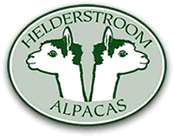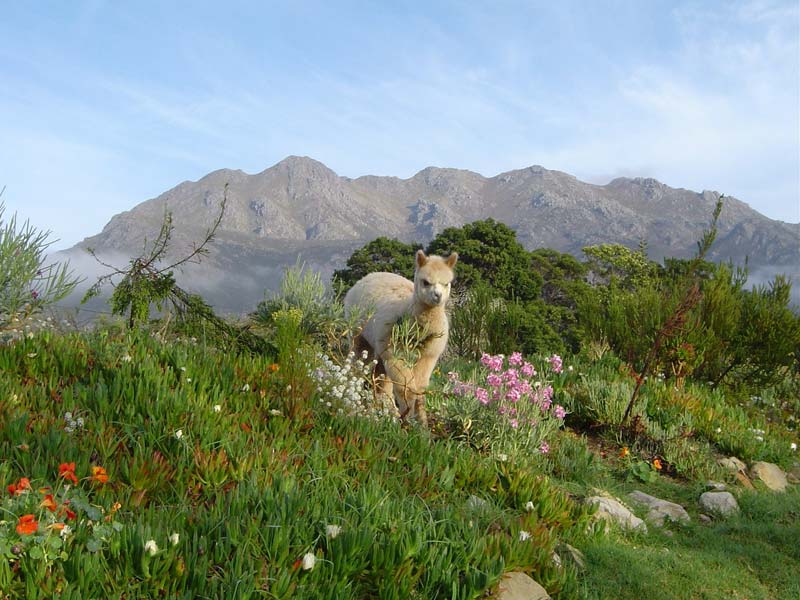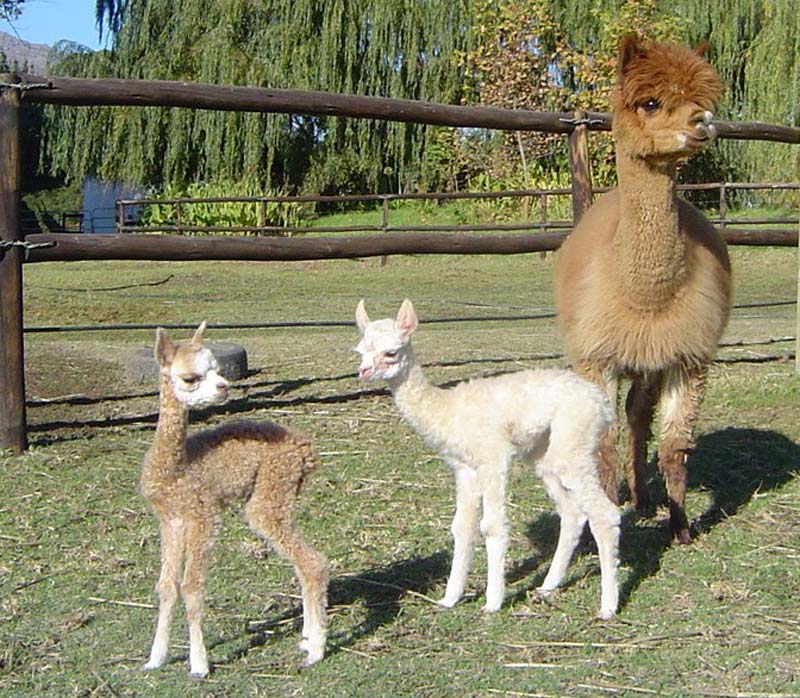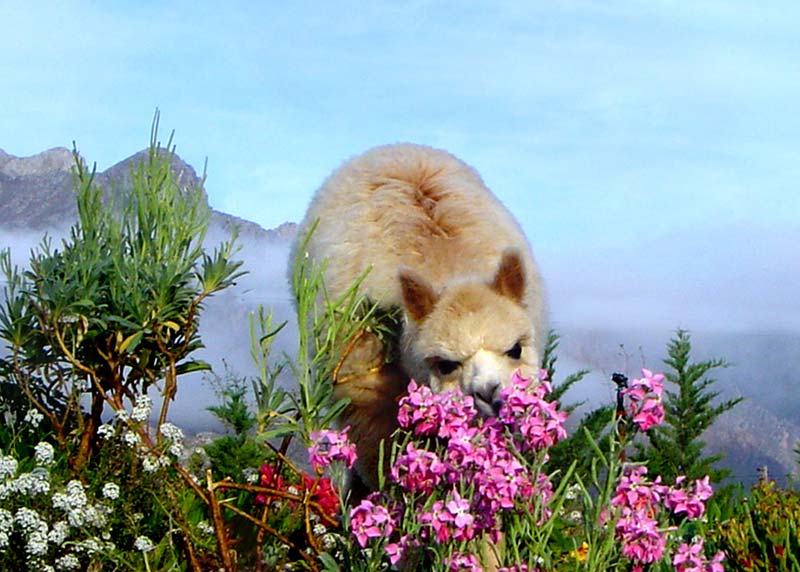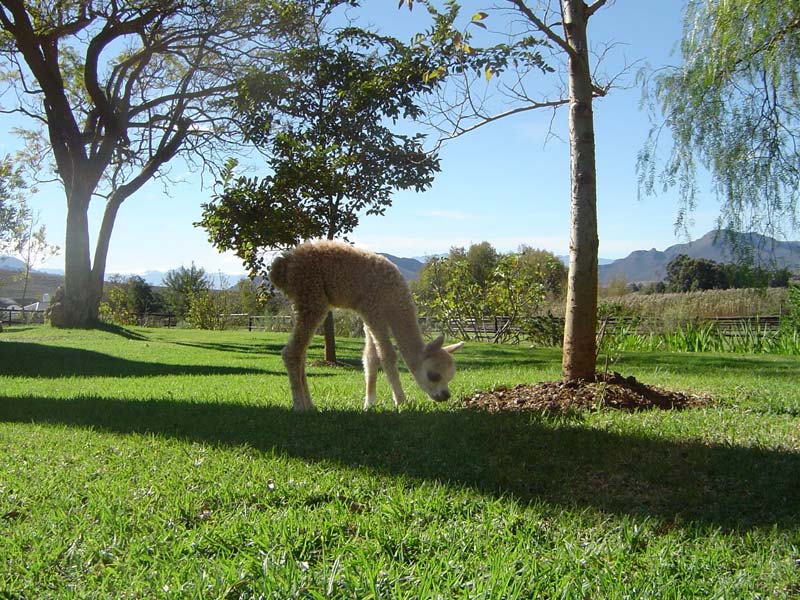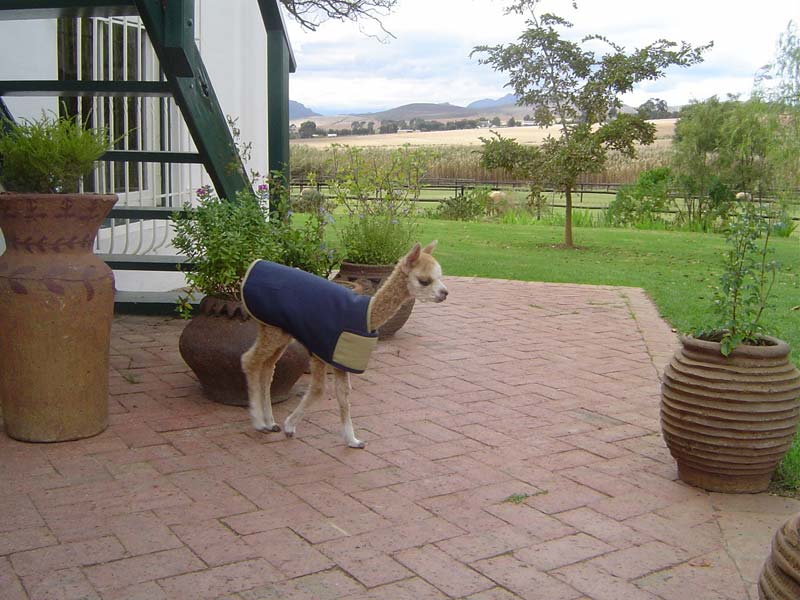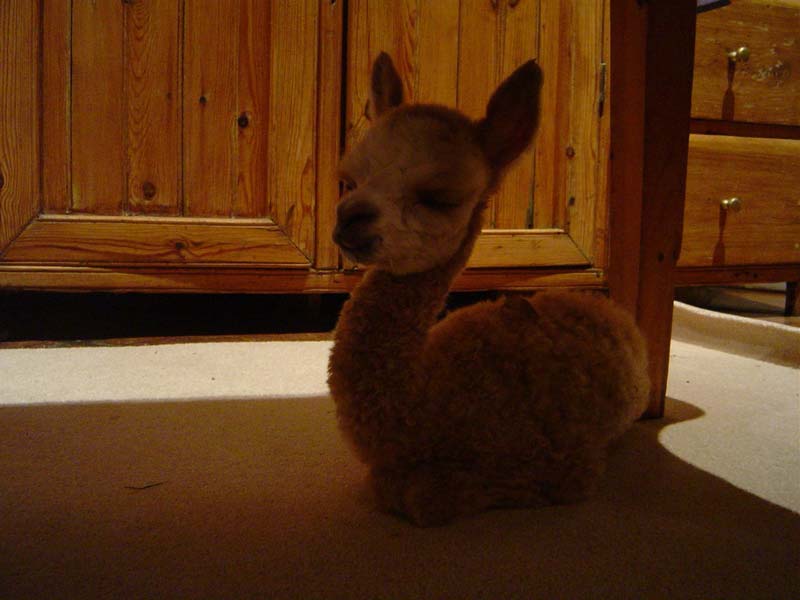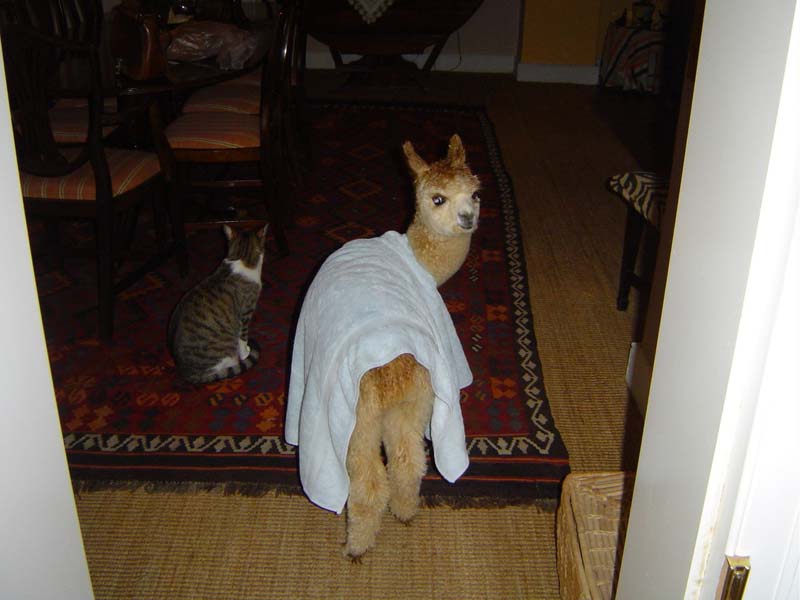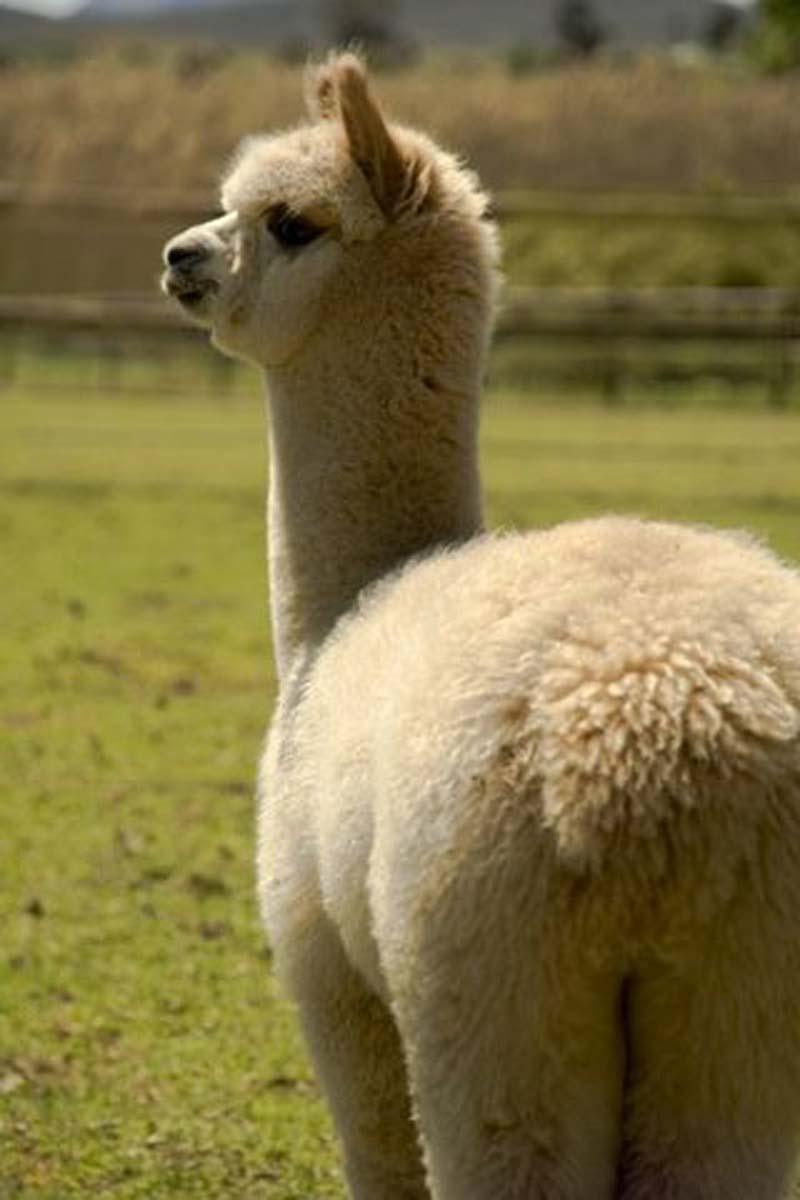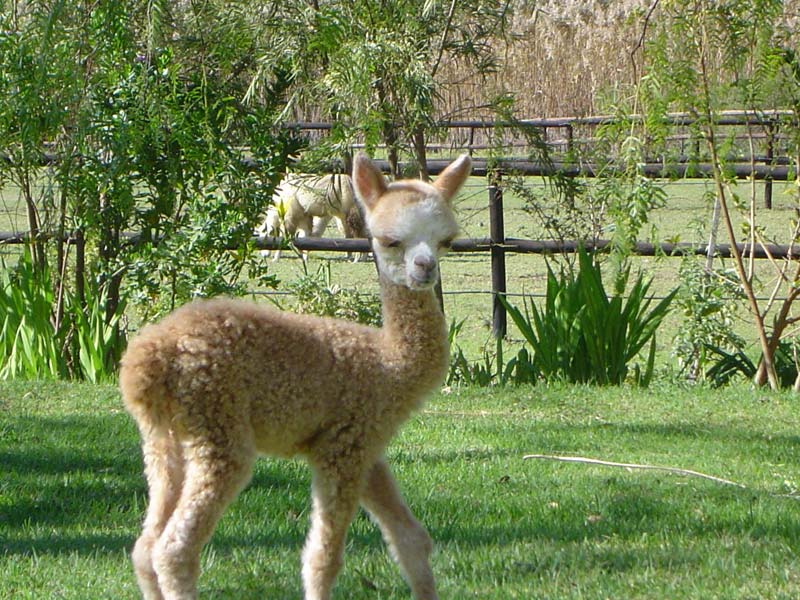Image
Gallery
The Story of Pepper
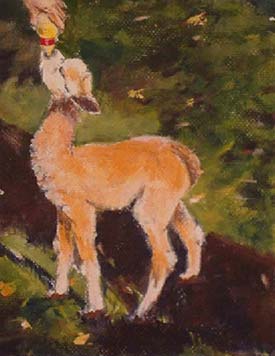 Picture published by kind permission of the artist, Margaret Ramsay
Picture published by kind permission of the artist, Margaret Ramsay
May in the Western Cape is autumn with crisp mornings, sunny days and cool nights. May 11th, 2009 was one of these days and was the day that Brenda began spinning for us.
By 10 am that morning Brenda needed a break and I suggested we go down to where the mums and babies were. In fact it was baby as only one cria had been born so far that season, just three days previously.
Taki was a maiden, very pregnant, and was walking around with her tail elevated and showing all the signs that birthing was imminent. Unusually late in the morning, we thought, as most are born between 7.30 am and 10-ish. We watched her carefully from then onwards, checking her every 15 minutes or so. At lunch time her contractions began and, sure enough, there was the cria visible … a nose but no legs. Try as we might we could not find the tiny forelegs and as an hour elapsed we phoned our local vet, Pietie le Roux.
Pietie came within a quarter of an hour, immediately found the forelegs and out came a tiny – really tiny – white female cria. Great, we thought, a girl … but SO small. Anyway she kicked and stumbled to her feet, fell over, got up again, all the usual things crias do when entering the world. We started to rub her dry with a towel while, at the same time, failing to notice that Pietie was carrying out a post natal examination on Taki who was still down. Almost at once Pietie announced, “TWINS!” to which we replied in unison, “No Pietie, alpacas don’t have twins”. With that a second pair of forelegs were presented and out into the world slipped the most frightening sight … the tiniest alpaca, literally like a scrap of meat on legs, and a head at the end of a long seemingly hopeless neck that the cria could not hold up. But … it was alive, just.
To ensure it remained alive, Pietie swung her round his head to clear her little airways which were blocked. That, followed by a tickle in the nose with a piece of dry grass – which induced a huge “newborn” sneeze – and the little fawn cria began breathing normally.
The books all spell doom and gloom as far as twin alpacas are concerned and yet here were two live girl crias. Tiny, but alive. Now it was our job to keep this minute alpaca going. Taki bonded with her firstborn whom we named Salt but could not understand, nor did she want to understand, Pepper.
We thought there must have been something wrong with our scales when Salt weighed in at 3.7 kgs and Pepper 2.4 kgs. Normal birth weight is from 6.5 kgs to around 8.5 kgs. Unfortunately they were accurate. Salt remained with her mum and although small, she suckled happily until she was weaned… and this is where we leave Salt and tell The Story of Pepper.
There was no way we could leave, or would have left, Pepper with her mum to wait and see what would happen. We had bred twins. That in itself is extraordinary. So we picked up this little bundle and brought her into the house.
The previous year we had tragically lost a mare to colic when her foal was only four months old. We still had a bag of Denkavit foal milk replacer in the stables. I rushed to get it, then I dashed to the computer and went to Denkavit’s website and looked up their recommendations for feeding an orphaned calf or lamb, took a midway average (but this was now foal milk replacer, remember?) and this is what we brought tiny Pepper up on. In fact we made some home made colostrum to bump start her during these vital first few days and added a few supplements such as an egg into a two litre milk mix, olive oil, some honey and some bee propolis, natures own antibiotic.
Although rejected by mum, we did manage to sneak a feed on day two by distracting Taki with pellets and pointing Pepper’s nose at the milk bar. What we also did was to rub both babies with the afterbirth so as to dissipate the human smell which Pepper would by now have adopted. That feed, which lasted exactly seven minutes, is sadly the only time Pepper has suckled her mother. It was imperative that she suckled during the two-day window when Taki would be producing colostrum since there is no transfer of antibodies prior to birth.
Despite the fact Pepper was a rejected child she was never ever depressed. On the contrary, she very soon learned her name and would prick up her ears when she heard it called. We covered the tiles on the kitchen floor with offcuts of carpet to prevent her doing the splits and she would cush down on the floor, warm from the underfloor heating and during the winter months while she was so frail and small we would put a hot water bottle around her bottom. All our cria coats resembled giant dressing gowns on Pepper so we made her her own specially designed coat … alpaca-filled, of course!
For the first three weeks of her life no-one left her side except between the midnight and 3 am feed and that one and the 6 am feed. Oh dear, getting out of bed to do the 3 am feed in mid winter was not fun at all! During the daytime one of us would sit with her in the paddock watching and monitoring her every move. We do have eagles in our mountains and imagine having got this far to then see her being carried off by a hungry raptor. We took no risks at all and even went as far as cancelling social engagements in order to be here 24 hours a day to protect and nurture our baby.
Pepper never once lost weight, and neither did Salt. Pepper had a sucking reflex as strong as any storm drain and she avidly drank just about everything she was given. She had, after all, gone to full term. She was small but this had not been a premature birth. They were both weighed every single day until they were about 20 kgs. Sometimes their weight stood still for a day but the following day there would be a larger than usual increment. We opened a bottle of Champagne when at four weeks old Pepper reached 5 kilograms – more than double her birth weight – and she was six weeks old before she reached what would have been an acceptable birth weight.
For the first five months of Pepper’s life she preferred to graze around the garden, nibble the pot plants or be in the house following us around. Indeed she slept in the kitchen with our three blue roan cocker spaniels. She is totally domesticated and was housetrained by about a month old. We would bottle feed her on the lawn outside the kitchen door and almost immediately, sometimes simultaneously, she would wee. So she related the two activities and we rarely had an accident. We hum to her and she hums back. After all we have been her adoptive ‘mothers’. If we go out in the car she comes to welcome us home and when visitors arrive Pepper is the first at the car to see who’s come.
And now, during the hot months when she isn’t with her twin sister and cousins she likes to sit in the shade on the alpaca workshop veranda outside of where our two spinners and I work the fibre. The floor in here is tiled, and slippery for an alpaca, so she will potter in, wander right up to Brenda and Theresa, have a good look at their spinning (my quality controller) and then potter out again. Friends love it when they sit down with a drink and an alpaca sitting beside them. We play with her, neck wrestle with her and at night times when we do a last check on the horses in their stables Pepper pronks in the shadows until it is time for her to go to the pens. Yes, Pepper is finally learning to be an alpaca.
We shear in October in the Cape, just before the onset of the hot season. If looks could kill … Pepper hated every minute of shearing – you can’t blame her – and I could barely look her in the eye. I felt I’d betrayed her having to go through this ordeal! I have carded and spun the twins’ lovely baby fibre together to a sort of honey blonde colour. Of course it was only fair to blend the two – I couldn’t favour Pepper over Salt on this occasion. This yarn is very definitely for me! We are unlikely ever to repeat this extraordinary phenomenon and besides who could ever afford such a unique garment?
We have been breeding alpacas since 2004. Whether the birth of the twins was beginner’s luck we don’t know. Whatever it was these twins have been a rare privilege and are a delight.
The end
Alison Notley
Helderstroom Alpacas
February 2010
